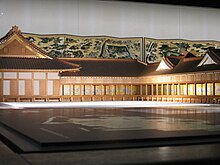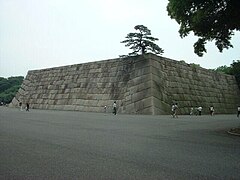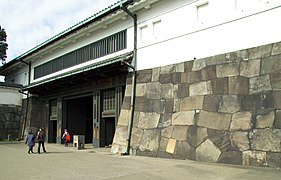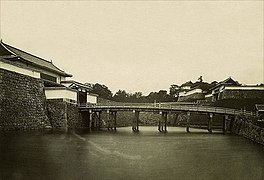Edo-jō
| Edo-jō | |
|---|---|
|
Castle complex (detail) before 1657 (view to the west) |
|
| Alternative name (s): | Chiyoda-jō |
| Creation time : | 1457 |
| Castle type : | Hirayamajiro (hill castle) |
| Conservation status: | Ramparts, walls, ditches and gates (partly) preserved |
| Construction: | Stone, wood |
| Place: | Tokyo |
| Geographical location | 35 ° 41 '18 " N , 139 ° 45' 15.8" E |
The Edo-jō ( jap. 江戸城 ., Dt "Edo Castle") in Chiyoda , the center of Tokyo, the largest castle in Japan and seat was the Tokugawa - Shoguns .
Emergence
The castle was built in 1457 by the military strategist Ōta Dōkan in today's Tokyo , which was then called " Edo ", but fell into disrepair after his death. Tokugawa Ieyasu , who had transferred the provinces around Tokyo Bay from Toyotomi Hideyoshi in 1590, decided to renovate this castle. The Sengoku era was over, but it was still necessary to secure yourself and your family. For that, Ieyasu, the remote castle located on a mountain nose above Tokyo Bay, must have just appeared right. The hilly, arid area was less suitable for the expansion of the associated fishing village into a castle town ( Jōkamachi ).
The castle complex
After Ieyasu took power in the country in 1600, Japan was ruled from the castle, which has now been expanded. The castle (outlined in red on the plan) followed the pattern of the times and consisted of the main castle - Honmaru (outlined in orange on the plan) on the mountain nose - and a number of outer castles. Castle and bailey were protected by trenches, ramparts and at important points by defense towers (yagura) and secured gates.
In front of the actual castle, the most important followers received their properties, which were also protected by moats, walls and gates. In the plan these are 8, 9 and 10, which are shown on the corresponding kiri-ezu as "Go-kuruwa-nai daimyō kōji" ( 御 曲 輪 内 大名 小路 ). The entire location, i.e. the castle and daimyo residences, were enclosed by a moat that could only be passed through secured gates, the "Inner Moat " ( 内 堀 ・ 内 濠 ) Uchibori.
The Honmaru
The Honmaru was entirely filled by the extensive main residence. This burned down during the Meireki fire in 1657, but was restored in 1659. In 1858 the residence burned down completely, but was at least partially rebuilt. The residence was torn down at the beginning of the Meiji period , but we have the most detailed information about the complex from plans that have been handed down. It was laid out on one level and contained many inner courtyards. The castle had, as is usual with Prince residences, a front part (1a), ( 表,御殿 , omote, goths), which the audience rooms, a Noh included -Bühne and the private quarters of the Shogun. In a separated part behind (1b) were the living rooms of the woman, those of the concubines and the maids as well as the kitchen rooms, storerooms, etc. This area, usually called "oku", "the back [part of the house]", was named here because of its size "Ōoku" ( 大 奥 ). Men were strictly forbidden to enter without permission.
The Tenshukaku
The usual wooden tower ( 天 守 閣 ) of a Japanese castle originally belonged to the residence . It was built in 1606 at the highest point of Honmaru, behind the Ōoku at the north end (purple square in the plan) with 5 floors on a stone base of 36.5 m × 33 m. Plans of the tower have been handed down that show it is over 50 m high. This made him the highest tenshu in Japan. It had to be repaired in 1622 and 1637, was given white plaster once and dark wood paneling the second time.
After the destruction in the Great Meireki Fire in 1657, the elaborate structure was not rebuilt, especially since the Tokugawa Shogunate was no longer in question after the Toyotomi was destroyed in 1615. Japanese historical films (" jidaigeki "), such as " Abarembo Shogun ", which are set in Edo, often show the castle with a keep, which, however, comes from Himeji Castle . The association "Edo-jō saiken o mezasu kai" ( 江 戸 城 再 建 を 目 指 す 会 , English "Rebuilding 'Edo-jo' Association") has set itself the goal of reconstructing at least the main tower of the castle in a historically accurate way.
The incident at Matsu no Ōrōka
The "Matsu no Ōrōka" ("Large Pine Corridor") was a connecting corridor between the "Shiroshoin" and the audience hall "Ōhiroma". Its name is derived from the painted sliding doors with pine motifs. On April 21, 1701 Asano Naganori drew his wakizashi on this corridor and injured Kira Yoshinaka out of anger over his deliberately wrong advice at court. This led to what became known as the " Story of the 47 Rōnin ".
The other Maru
- The Ni-no-maru below the Honmaru (on plan 2) contained a small residence with a no-stage.
- The narrow San-no-maru (3) formed the outermost protection of the castle.
- A second large residence was located in Nishi-no-maru (4). It burned down completely in 1838 and 1852 and partially in 1862. A provisional reconstruction took place in 1863. The Shogun's extensive library was also located in Nishi-no-maru on a hill called “Momijiyama”. The family's graves were also located there (5).
- The area called Fukiage (6) consisted of green spaces and contained a riding arena.
- After 1700, the two Gosankyō families Tayasu, Shimizu, resided in Kita-no-maru (7) . Since then this area has not belonged to the castle.
The castle after 1868
When the ruling shogun lost his power in 1868, the representative of the imperial troops Saigō Takamori and the negotiator of the shogunate Katsu Kaishū agreed on a peaceful surrender of the city and the castle. The castle was first renamed Tōkei-jō ( 東京 城 , dt. "Tokei Castle"), then in 1869, when it became the seat of the imperial court , in Kōjō ( 皇城 , dt. "Imperial Castle"). The main residence was no longer habitable at the end of the Edo period. So the Tennō took over the existing residence in the western part of the castle, in Nishi-no-maru. However, this residence burned down on May 5, 1873, the Tennō moved to the nearby former residence of the Kii branch of the Tokugawa. It was not until 15 years later, in 1888, that the new residence ( 皇居 , Kōkyo, dt. "Tennō residence") could be obtained. The eastern and northern parts of the former castle complex are used in a variety of ways and are open to the public. In 1963 the castle was declared a Special Historic Site ( tokubetsu shiseki ).
heritage
Many places in Tokyo take their name from Edo Castle. " Ōtemachi " ("city in front of the main gate"), "Takebashi" ("bamboo bridge"), "Uchibori-dōri" ("street at the inner ditch") and " Marunouchi " ("in the enclosure") are examples.
Picture gallery
Outer Sakurada Gate, where
Ii Naosuke was murdered in 1860
Individual evidence
- ↑ TOP ペ ー ジ . 江 戸 城 再 建 を 目 指 す 会 , accessed on December 1, 2009 (Japanese).
Remarks
- ↑ Area 9 is the Marunouchi district with Tokyo Central Station at 9.
- ↑ Another ring moat is the " Äussere Graben" ( 外 堀 ・ 外 濠 ), which surrounds the inner area of the city. That corresponds to today's Chiyoda district without Kanda.
- ↑ The third family of the Gosankyō, Hitotsubashi, received an estate at the bridge that gave it its name.
- ↑ Not all Samurai loyal to the Shogun disagreed with this. So it came to fighting over the Ueno hill with the Kanei-ji .
literature
- Oleg Benesch and Ran Zwigenberg: Japan's Castles: Citadels of Modernity in War and Peace. Cambridge, 2019, ISBN 9781108481946 .
- Tokyo-to rekishi kyoiku kenkyukai (ed.): Tokyo-to no rekishi sanpo (jo). Yamakawa, 2001, ISBN 4-634-29130-4 .
- Murai Masao: Edo-jō. Chuko shinsho 45. Chuokoronsha, 1964, ISBN 412-100045-5 .









